Difference between revisions of "Autographic"
m (+new wikilink) |
(+ a number of patents, so far describing versions that weren't made commercially, I think) |
||
| Line 1: | Line 1: | ||
| − | |||
{{Flickr_image | {{Flickr_image | ||
|image_source= http://www.flickr.com/photos/captkodak/272746536/in/pool-camerawiki | |image_source= http://www.flickr.com/photos/captkodak/272746536/in/pool-camerawiki | ||
| Line 36: | Line 35: | ||
{{brl}} | {{brl}} | ||
| − | '''Autographic film''' allows the photographer to enter his own notes onto the negative. Comments are scratched into paper on the back of the film with a stylus and then exposed to the sun and burned onto the negative. The method was invented by [[Gaisman| | + | '''Autographic film''' allows the photographer to enter his own notes onto the negative. Comments are scratched into paper on the back of the film with a stylus and then exposed to the sun and burned onto the negative. The method was invented by [[Gaisman|Henry Jaques Gaisman]], who developed it over several years and held a number of patents with [[Kodak|Eastman Kodak]]. Kodak made a series of Autographic cameras and even replacement backs to adapt older cameras to use this feature, and produced Autographic film for 8 different negative sizes. |
| + | |||
| + | The form of the window can help date the camera, as Kodak produced three consecutive models in 20 years. Middle and later versions are shown below. | ||
{{Flickr_image | {{Flickr_image | ||
| Line 77: | Line 78: | ||
{{brl}} | {{brl}} | ||
== Links == | == Links == | ||
| + | * Patents held by Henry J. Gaisman relating to Autographic cameras, at [http://worldwide.espacenet.com/?locale=en_EP Espacenet], the patent search facility of the European Patent Office: | ||
| + | ** [http://worldwide.espacenet.com/publicationDetails/originalDocument?CC=US&NR=1272415A&KC=A&FT=D&ND=3&date=19180716&DB=worldwide.espacenet.com&locale=en_EP US Patent 1272415], ''Method of and apparatus for producing designations upon photographic material'', filed 23 March 1911 (as application no. 616428: see the following two patents), and granted 16 July 1918 to H.J. Gaisman, ''as assignor to Eastman Kodak Corporation''. The patent describes a method of leaving marks that will appear in the negative upon development, by writing on the film, which is beneath a lightproof but flexible cover, with a stylus. Gaisman specifically allows for two ways this might work: (i) by the transfer of powdered material (i.e. carbon, from a duplicating paper) to the film, under the stylus' pressure, and (ii) any direct effect of the pressure on the film itself: it is stated that writing on the film against a roughened or patterned support also produces lettering in the negative, but this is only one option. In the basic form of the camera described, the roll film passes across a narrow shelf, on which is mounted a strip of carbon paper (or a textured panel). Thus writing with the stylus transfers carbon to the emulsion side of the film, before exposure in the camera. The shelf, which is required to allow the stylus to apply suitable pressure, must then be moved out of the way before exposure. An alternative design is described, in which the writing panel is positioned at the top of the camera; the film is written on, then advanced, and only then exposed; this removes the need to move the supporting shelf each time. | ||
| + | **[http://worldwide.espacenet.com/publicationDetails/originalDocument?CC=US&NR=1359245A&KC=A&FT=D&ND=3&date=19201116&DB=worldwide.espacenet.com&locale=en_EP US Patent 1359245], ''Photographic apparatus'', originally filed 23 March 1911 as part of no. 616428, but divided and re-filed separately 29 March 1912 and granted 16 November 1920 to Gaisman, again as assignor to Eastman Kodak. The patent describes a refinement of the basic autographic feature, in which a transparent tape passes across the front of the film in the exposing frame of the camera. This is held on feed and uptake rollers. Before passing into the film compartment, the tape passes across the back of the camera, where the user can write the desired inscription. The tape need not be advanced for every exposure; the same legend can be used for a series of pictures. | ||
| + | **[http://worldwide.espacenet.com/publicationDetails/originalDocument?CC=US&NR=1359246A&KC=A&FT=D&ND=3&date=19201116&DB=worldwide.espacenet.com&locale=en_EP US Patent 1359246], ''Apparatus for producing designations upon photographic material'', again originally filed as part of no. 616428, but divided and re-filed separately 28 May 1917, and granted 16 November 1920 to Gaiman and Eastman Kodak. This patent describes another refinement of the feature, in which inscriptions are written on small strips of transparent material (it suggests celluloid or gelatin). The strip is mounted in a stiffening frame, and inserted into the camera through a slot. | ||
| + | **[http://worldwide.espacenet.com/publicationDetails/originalDocument?CC=US&NR=1249612A&KC=A&FT=D&ND=3&date=19171211&DB=worldwide.espacenet.com&locale=en_EP US Patent 1249612], ''Photographic apparatus'', filed 29 March 1912 and granted 11 December 1917, again to Gaisman as assignor to Eastman Kodak. This patent describes an implementation of the idea above, in a folding roll-film camera. The holder carrying the inscription is placed in a tray on one side of the camera, the tray is closed to light, and the holder then swung into position. | ||
| + | ** [http://worldwide.espacenet.com/publicationDetails/originalDocument?CC=US&NR=1230399A&KC=A&FT=D&ND=3&date=19170619&DB=worldwide.espacenet.com&locale=en_EP US Patent 1230399], ''Photographic apparatus'', filed 29 March 1912 and granted 19 June 1917 to Gaisman and Eastman Kodak. This patent describes a camera much more like those Eastman eventually sold. A panel in the camera back can be opened, allowing the user to write on a section of the film ''protected from exposure via the lens''. Beneath the writing panel, the film is still protected by an opaque but flexible cover. Under this, the film passes across a supporting 'beam' made from glass, with a roughened upper surface. Under pressure from the stylus, the surface of this beam makes impressions in the emulsion which lessen its response when exposed to light. The light to expose the written panel enters via two tubes under the cover, one leading to each end of the glass beam. The light passes along the beam itself, so the film is exposed ''from the emulsion side'', although the light enters from the cover in the back. | ||
| + | |||
| + | |||
* [http://www.vintagephoto.tv/autofilm.shtml Autographic film on Scott's photographica ] | * [http://www.vintagephoto.tv/autofilm.shtml Autographic film on Scott's photographica ] | ||
<!-- * [http://nzcp.wellington.net.nz/nzcpexpo/ff98cams/ff98c07.htm Sample of Autographic photo on NZCP ] --> | <!-- * [http://nzcp.wellington.net.nz/nzcpexpo/ff98cams/ff98c07.htm Sample of Autographic photo on NZCP ] --> | ||
Revision as of 19:03, 16 October 2014
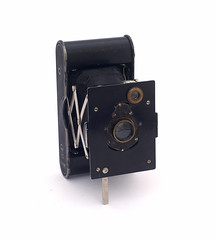
|
| Vest Pocket Autographic image by Steve Harwood (Image rights) |
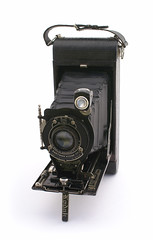
|
| No. 1A Pocket Kodak image by Steve Harwood (Image rights) |

|
| The lady writes something onto her film scanned by Mario Groleau (Image rights) |
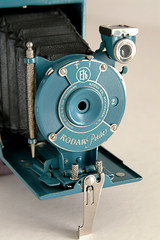
|
| Front-mounted stylus image by Geoff Harrisson (Image rights) |
Autographic film allows the photographer to enter his own notes onto the negative. Comments are scratched into paper on the back of the film with a stylus and then exposed to the sun and burned onto the negative. The method was invented by Henry Jaques Gaisman, who developed it over several years and held a number of patents with Eastman Kodak. Kodak made a series of Autographic cameras and even replacement backs to adapt older cameras to use this feature, and produced Autographic film for 8 different negative sizes.
The form of the window can help date the camera, as Kodak produced three consecutive models in 20 years. Middle and later versions are shown below.
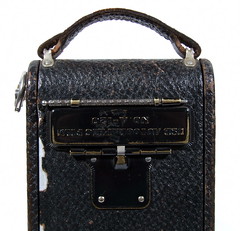
|
| Window and stylus No. 1 Autographic Kodak Jr. image by Süleyman Demir (Image rights) |
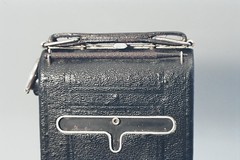
|
| Window of No. 1 Pocket Kodak image by Dries van den Elzen (Image rights) |

|
| A127 size autographic negative image by Geoff Harrisson (Image rights) |
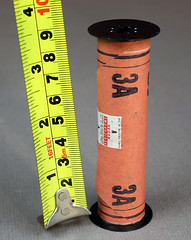
|
| Autographic Verichrome Film Size A122 image by Frank Reiser (Image rights) |
Links
- Patents held by Henry J. Gaisman relating to Autographic cameras, at Espacenet, the patent search facility of the European Patent Office:
- US Patent 1272415, Method of and apparatus for producing designations upon photographic material, filed 23 March 1911 (as application no. 616428: see the following two patents), and granted 16 July 1918 to H.J. Gaisman, as assignor to Eastman Kodak Corporation. The patent describes a method of leaving marks that will appear in the negative upon development, by writing on the film, which is beneath a lightproof but flexible cover, with a stylus. Gaisman specifically allows for two ways this might work: (i) by the transfer of powdered material (i.e. carbon, from a duplicating paper) to the film, under the stylus' pressure, and (ii) any direct effect of the pressure on the film itself: it is stated that writing on the film against a roughened or patterned support also produces lettering in the negative, but this is only one option. In the basic form of the camera described, the roll film passes across a narrow shelf, on which is mounted a strip of carbon paper (or a textured panel). Thus writing with the stylus transfers carbon to the emulsion side of the film, before exposure in the camera. The shelf, which is required to allow the stylus to apply suitable pressure, must then be moved out of the way before exposure. An alternative design is described, in which the writing panel is positioned at the top of the camera; the film is written on, then advanced, and only then exposed; this removes the need to move the supporting shelf each time.
- US Patent 1359245, Photographic apparatus, originally filed 23 March 1911 as part of no. 616428, but divided and re-filed separately 29 March 1912 and granted 16 November 1920 to Gaisman, again as assignor to Eastman Kodak. The patent describes a refinement of the basic autographic feature, in which a transparent tape passes across the front of the film in the exposing frame of the camera. This is held on feed and uptake rollers. Before passing into the film compartment, the tape passes across the back of the camera, where the user can write the desired inscription. The tape need not be advanced for every exposure; the same legend can be used for a series of pictures.
- US Patent 1359246, Apparatus for producing designations upon photographic material, again originally filed as part of no. 616428, but divided and re-filed separately 28 May 1917, and granted 16 November 1920 to Gaiman and Eastman Kodak. This patent describes another refinement of the feature, in which inscriptions are written on small strips of transparent material (it suggests celluloid or gelatin). The strip is mounted in a stiffening frame, and inserted into the camera through a slot.
- US Patent 1249612, Photographic apparatus, filed 29 March 1912 and granted 11 December 1917, again to Gaisman as assignor to Eastman Kodak. This patent describes an implementation of the idea above, in a folding roll-film camera. The holder carrying the inscription is placed in a tray on one side of the camera, the tray is closed to light, and the holder then swung into position.
- US Patent 1230399, Photographic apparatus, filed 29 March 1912 and granted 19 June 1917 to Gaisman and Eastman Kodak. This patent describes a camera much more like those Eastman eventually sold. A panel in the camera back can be opened, allowing the user to write on a section of the film protected from exposure via the lens. Beneath the writing panel, the film is still protected by an opaque but flexible cover. Under this, the film passes across a supporting 'beam' made from glass, with a roughened upper surface. Under pressure from the stylus, the surface of this beam makes impressions in the emulsion which lessen its response when exposed to light. The light to expose the written panel enters via two tubes under the cover, one leading to each end of the glass beam. The light passes along the beam itself, so the film is exposed from the emulsion side, although the light enters from the cover in the back.